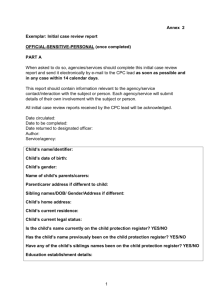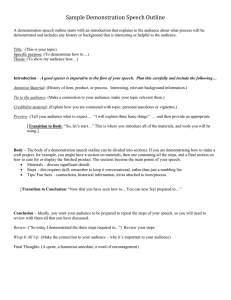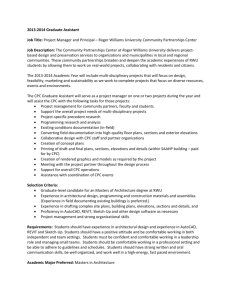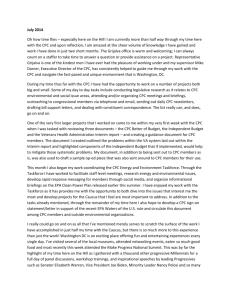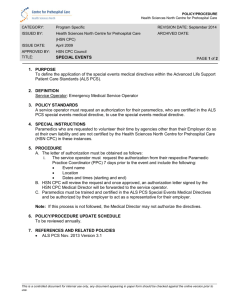CPC Report Content Requirements 2014
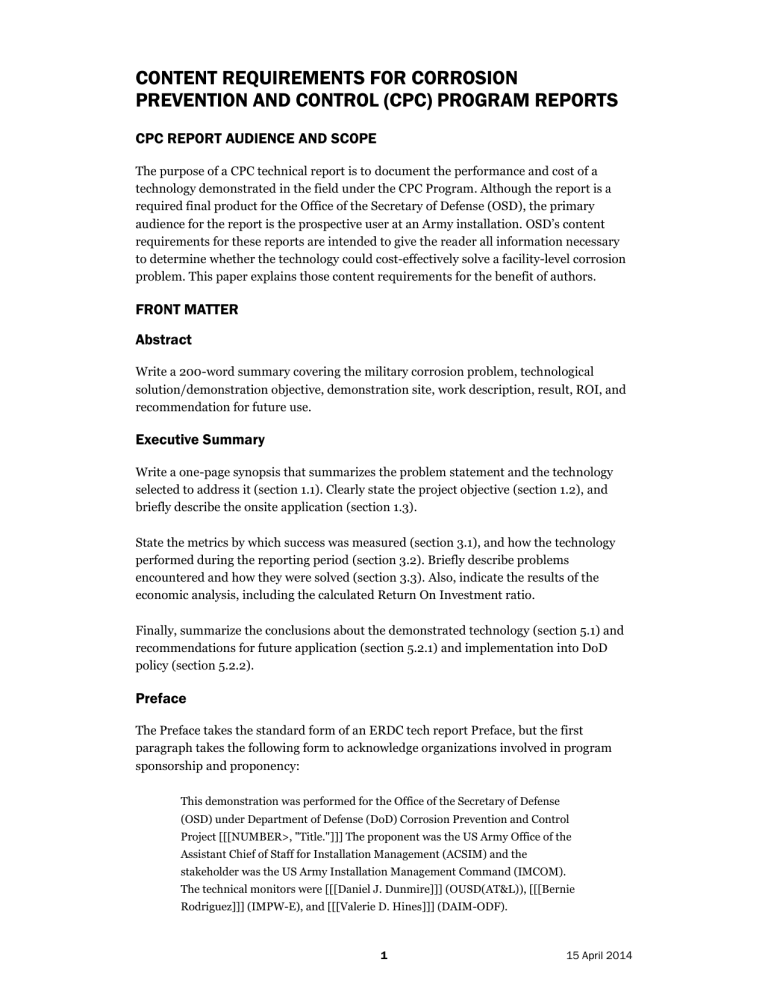
CONTENT REQUIREMENTS FOR CORROSION
PREVENTION AND CONTROL (CPC) PROGRAM REPORTS
CPC REPORT AUDIENCE AND SCOPE
The purpose of a CPC technical report is to document the performance and cost of a technology demonstrated in the field under the CPC Program. Although the report is a required final product for the Office of the Secretary of Defense (OSD), the primary audience for the report is the prospective user at an Army installation. OSD’s content requirements for these reports are intended to give the reader all information necessary to determine whether the technology could cost-effectively solve a facility-level corrosion problem. This paper explains those content requirements for the benefit of authors.
FRONT MATTER
Abstract
Write a 200-word summary covering the military corrosion problem, technological solution/demonstration objective, demonstration site, work description, result, ROI, and recommendation for future use.
Executive Summary
Write a one-page synopsis that summarizes the problem statement and the technology selected to address it (section 1.1). Clearly state the project objective (section 1.2), and briefly describe the onsite application (section 1.3).
State the metrics by which success was measured (section 3.1), and how the technology performed during the reporting period (section 3.2). Briefly describe problems encountered and how they were solved (section 3.3). Also, indicate the results of the economic analysis, including the calculated Return On Investment ratio.
Finally, summarize the conclusions about the demonstrated technology (section 5.1) and recommendations for future application (section 5.2.1) and implementation into DoD policy (section 5.2.2).
Preface
The Preface takes the standard form of an ERDC tech report Preface, but the first paragraph takes the following form to acknowledge organizations involved in program sponsorship and proponency:
This demonstration was performed for the Office of the Secretary of Defense
(OSD) under Department of Defense (DoD) Corrosion Prevention and Control
Project [[[NUMBER>, "Title."]]] The proponent was the US Army Office of the
Assistant Chief of Staff for Installation Management (ACSIM) and the stakeholder was the US Army Installation Management Command (IMCOM).
The technical monitors were [[[Daniel J. Dunmire]]] (OUSD(AT&L)), [[[Bernie
Rodriguez]]] (IMPW-E), and [[[Valerie D. Hines]]] (DAIM-ODF).
1 15 April 2014
The placeholder text in triple brackets prompt the author for project-specific information and general sponsorship acknowledgments. The named individuals in the specimen above are not project-specific, so they may change from time to time. Ask the ERDC-
CERL CPC Program Manager if you are not sure.
Also, there is usually an acknowledgments paragraph immediately before the final paragraph. Because CPC demonstrations are almost always executed on Army installations, individuals at the site should be acknowledged as follows:
The following individuals are gratefully acknowledged for their contributions to this project:
• Person 1 — Title, Institutional Affiliation (OFFICE SYMBOL)
• etc.
MAIN BODY OUTLINE AND CONTENT REQUIREMENTS
1 Introduction
1.1 Problem statement
Briefly state the Army or DoD corrosion problem the project addresses, including how much the problem costs DoD annually and/or how it may negatively impact the military mission. Include a brief statement on how the subject technology solution could eliminate or reduce the negative impact of the problem. (Save a detailed description of the technology for section 2.1, “Technology overview.”) The Problem Statement usually runs 1
– 2 paragraphs.
1.2 Objective
Concisely describe the research objective in terms of the problem statement. Either use or lightly rewrite the project objective from the approved PMP. The Objective should be expressible in a single sentence, which may include a bulleted list if there are multiple sub-objectives.
1.3 Approach
The purpose of this section is to briefly describe the salient points of the demonstration, including where and when it was executed, and generally what was involved in the field work. Reserve the full discussion for sections 2.2 and 2.3. Also, do not go into detail about the technology here; save that for section 2.1.
Also, briefly describe the metric for a successful application in terms of performance and/or cost. However, save a full discussion of metrics for section 3.1.
2 Technical Investigation
2.1 Technology overview
The purpose of this section is to provide a clear and complete description of how the subject technology works, but avoid excessive detail. Do not recap the problem statement
2 15 April 2014
here; refer the reader back to section 1.1 if necessary. Illustrate all components of the system with explanatory diagrams or photographs.
2.2 Field work
Describe the work plan for implementing the technology at the demonstration site.
Indicate any permits required by law or regulation, and any coordination needed with utility companies or other local stakeholders. Discuss all relevant field work in chronological order. Include any required ancillary tasks that significantly affect costs, such as steel surface preparation, the erection of temporary containment structures, or inspections and repairs needed before the technology can be properly implemented or installed.
Discuss any difficulties encountered when installing the technology or preparing the site beforehand. Include any contracting or procurement problems that a potential user might encounter. Provide detail only where the problems were disruptive and/or where the solution required significant unplanned effort. Do not over-explain minor, routine
problems. Discuss generalized solutions to all significant problems in section 3.3,
“Lessons learned,” not in this section.
Do not describe routine administrative activities such as kickoff meetings, procurement of equipment, monthly reporting, etc.
Finally, describe any significant site cleanup or waste disposal that was necessary before the technology could be put into use. Examples include backfilling of excavations, disposal of demolition waste, and disposal of hazardous substances.
2.3 Commissioning and monitoring
The purpose of this section is to describe how the technology was validated for operation and how performance was tracked. Do not discuss actual data or findings here; that discussion belongs in section 3.2.
First describe any testing, commissioning, inspection, or other tasks performed to verify that the technology was correctly installed and ready for use. Then discuss the procedure for periodic inspection and/or continuous performance monitoring that began after system validation. Also discuss any concurrent testing activity, such as setup of environmental exposure coupons or in-lab testing activities. Again: do not present data or findings here, just the infrastructure and procedures set up to monitor performance.
3 Discussion
3.1 Metrics
Begin this section with a clear statement of the performance goal by which success of the technology was measured.
List the industry standards that were used as metrics to empirically document technology performance. Examples include methods or test procedures published by standards bodies such as NACE International, ASTM International, etc. These standards can be
3 15 April 2014
presented here as short cites in the form of a bulleted list. Full citations must be included in the back matter, under “References.”
Do not present technology performance data in this section; reserve it for section 3.2.
3.2 Results
The purpose of this section is to summarize the results of the demonstration as of the end of the 2 year performance period. It will include a narrative account of system performance based on collected data, onsite inspections, and other relevant sources of information. Illustrate the text with data tables, plots comparing performance changes or benefits over time, photographs of the system in place, coupon test results, and the like.
Include explanations of problems that arose during system operation. (Do not restate the problems identified in field work section 2.2). Write enough to tell what happened and how it was addressed, but save the statement of “lesson learned” for section 3.3.
Discuss only the facts a reader will need in order to understand what happened during the demonstration. Include “statistically dense” technical information in this section by reference only, putting the actual data in appendices.
Do not interpret the results in this section, just report them. Interpret the results for the reader under Conclusions (section 5.1) and reserve comments about the suitability for
DoD-wide adoption for Recommendations (section 5.2).
3.3 Lessons learned
This section is intended to explain problems that a prospective user is likely to encounter during setup and operation of the technology at a military installation.
Discuss the lessons learned from addressing problems that emerged during field application of the technology (sections 2.2 and 2.3) and operation of the technology during the demonstration performance period (section 3.2). Don’t reiterate those problems in detail, just cross-reference the earlier description. Use this section to provide simple recommendations that will help new users avoid those problems.
If there were no problems encountered, do not “invent” lessons learned just to fill in this section. Simply state that the technology was procured, applied, and operated with no significant problems.
4 Economic Analysis
The purpose of this chapter is to account for the life-cycle costs of using a conventional corrosion-protection approach versus using the demonstrated technology, and calculating the return on investment (ROI) on the demonstrated technology that a military user could expect over 30 years. The only acceptable method of ROI calculation is that described in Office of Management and Budget (OMB) Circular No. A-94, Guidelines and
Discount Rates for Benefit-Cost Analysis of Federal Programs.
4 15 April 2014
The Word template for CPC reports (CPC Final Report Template 2014.dotx) includes a set of prompts that authors can use to structure Chapter 4, including a facsimile of the official ROI table (which is derived from an Excel spreadsheet). Below are the content requirements.
4.1 Costs and assumptions
Baseline Case for Existing Technology. Cover the costs expected if the site continued to use the conventional technology or methods currently in place at demonstration site. Include all first costs, annual operating and maintenance costs, and any periodic component replacement or refurbishment that would be expected during a
30-year service life. Explicitly state any other relevant assumptions.
Demonstrated System. State the direct first costs of procuring and installing the demonstrated technology, annual operating and maintenance costs, and any periodic component replacement or refurbishment that would be expected during a 30-year service life. Very important: also include demonstration-specific project-management
costs. Explicitly state all assumptions that uniquely relate to the subject technology, and justify any that may not be self-evident to a prospective user in the field.
4.2 Projected return on investment (ROI)
See the prompts included in the CPC report template (CPC Final Report Template
2014.dotx). The introductory paragraph restates, for context, the OMB-prescribed discount rate, the 30-year analysis period, the total demonstration cost, and the ROI ratio. The official CPC ROI table accounts for all costs for the baseline and demonstration scenarios, as specified in OMB Circular No. A-94.
After the table, brief contextual remarks also may be offered, if needed. One example would be a statement that certain demonstration costs (such as lab project management) included in the table would not be incurred in a typical field implementation. Another example would be a statement about how possible future technology cost changes could affect the stated ROI.
5 Conclusions and Recommendations
5.1 Conclusions
Briefly summarize the results given in section 3.2. Then interpret the results so the reader clearly understands the implications of technology performance in terms of corrosion prevention and control in real-world cases on military installations. Include concrete benefits, any significant problems, and costs versus the conventional baseline method available.
5.2 Recommendations
5.2.1 Applicability
Make a recommendation on whether DoD and the Army should adopt the demonstrated technology, and for what types of applications. Include relevant points from section 3.3
5 15 April 2014
(Lessons Learned) and Chapter 4 (Economic Analysis) if those affect how and where the technology might best be applied. Other points to cover could include geographic location, climate, and mission-criticality of infrastructure vulnerable to corrosion.
5.2.2 Implementation
The purpose of this section is to recommend which DoD engineering criteria documents should be revised to promote implementation of the demonstrated technology. Provide full cites for all relevant UFGSs, UFCs, and others.
For each of these documents, specify the paragraphs that should be revised and provide candidate language for how to incorporate the demonstrated technology. This will often require only a phrase added to current guidance indicating that the demonstrated technology is suitable for consideration when planning maintenance, repair, or rehabilitation activities. If lengthy or specialized implementation language is recommended, it can be presented in an appendix.
BACK MATTER
References
Every CPC report must include reference list, presented alphabetically by author. The first reference shown below relates to the Economic Summary, and it is included in all
CPC technical reports. The other citations show model examples for an ASTM standard, an ERDC technical report, an article from an online publication, a NACE standard, a US patent, a book, and a journal article. They are edited in the ERDC-standard format, which is based on The Chicago Manual of Style (16 th Edition). Use these as format models for
CPC references, and make your references as correct and complete as possible.
Office of Management and Budget (OMB). 1994. Guidelines and Discount Rates for Benefit-Cost
Analysis of Federal Programs. OMB Circular No. A-94. Washington, DC: Office of
Management and Budget.
ASTM International. 2008 Standard Test Method for Evaluation of Painted or Coated Specimens
Subjected to Corrosive Environments. D1654-08. West Conshohocken, PA: ASTM
International.
Bailey, D.M. August 2003. MicroROOFER for Windows User Guide Version 2.0. ERDC/CERL SR-
03-8. Champaign, IL: US Army Engineer Research and Development Center, Construction
Engineering Research Laboratory (ERDC-CERL).
Deign, Jason. 3 January 2012. "Make or break time for CIGS." PV Insider, http://news.pvinsider.com/thin-film-pv/make-or-break-time-cigs , accessed 4 April 2013.
NACE International. 2001. External Cathodic Protection of On-Grade Carbon Steel Storage Tank
Bottoms. RP0193-2001. Houston, TX: NACE International.
Pitts Jr., M. Michael. Electrostatic Device for Water Treatment. US Patent 5,591,317, filed 16
February 1994, and issued 7 January 1997.
Speyer, R.F. 1994. Thermal Analysis of Materials. New York: Marcel Dekker, Inc.
6 15 April 2014
Vand, V. 1948. “Viscosity of Solutions and Suspensions: Experimental Determination of the
Viscosity-Concentration Function of Spherical Suspensions.” Journal of Physical Colloid
Chemistry 52: 300–321.
Appendices
Don’t include the Project Management Plan or any other documents that do not illustrate how the technology works or provide performance data. Common appendix content may include relevant technical excerpts from manufacturer literature, Material Safety Data
Sheets (MSDS) for coatings or other materials used in field implementation, and remotemonitoring data (tables or plots). In some cases, sets of photographic documentation that are too large to include in the main text may be included as an appendix. Examples: sets of exposure coupons over time or chronological installation procedures in the field.
OTHER REPORT PREPARATION NOTES
Preformatted Typographic Stylesheets
The Word template for CPC reports (CPC Final Report Template 2014.dotx) has a built in stylesheet to help you correctly format the most common textual elements. If you don’t understand how to use the stylesheet, ask a technical editor before you begin.
Figures
All photographs must be in focus and not less than 300 pixels per inch in resolution. Do not compress JPEG images. Keep copies of all original figures in separate files until the report has been published.
The source of all figures that are not created by government personnel or government contractors as part of their official duties must be credited. Copyrighted pictures cannot be used unless the author is granted permission by the copyright owner. Generally, it is best to avoid using any pictures or other content from any source that is not explicitly in the public domain.
Insert all figures (photographs, diagrams, etc.) as in-line objects. Do not insert them as
wraparound objects; this adds considerable cost and time to the publication schedule.
Always place captions above the figure, not below. This style was new to ERDC in 2013.
Also, capitalize and punctuate captions as specified in the ERDC Reports Guide (2006).
Ask a technical editor for help if you do not understand the required formats.
Tables
Keep data tables visually simple. Use the sample table embedded in CPC Final Report
Template 2014.dotx as an example for typographical and border styles.
Standard Form 298
The editor will insert this and complete it. The form is required for all reports published to the Defense Technical Information Center (DTIC), which includes all CPC reports.
7 15 April 2014
